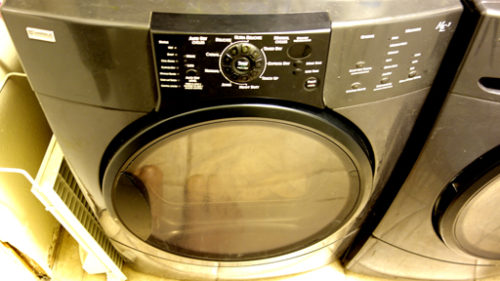Homeowner Quicktips – Dryer Safety
Homeowner Quicktips – Dryer Safety
Cleaning lint from a clothes-dryer vent is an important maintenance step that is often neglected.
 The vent pipe should be inspected and cleaned at least once a year. If allowed to accumulate, lint in the vent pipe is not only a fire hazard but can adversely affect performance of the dryer – sometimes making it difficult or impossible to get clothes completely dry.
The vent pipe should be inspected and cleaned at least once a year. If allowed to accumulate, lint in the vent pipe is not only a fire hazard but can adversely affect performance of the dryer – sometimes making it difficult or impossible to get clothes completely dry.
 The best bet is to remove the vent pipe entirely, take it outdoors and clean the interior with a brush or vacuum. Hold longer pipes vertically and bump the sides gently to help shake out clinging lint. Smooth metal vent pipe is recommended for dryers because they collect less lint. Collapsible plastic and metal pipes have crevices that trap lint.
The best bet is to remove the vent pipe entirely, take it outdoors and clean the interior with a brush or vacuum. Hold longer pipes vertically and bump the sides gently to help shake out clinging lint. Smooth metal vent pipe is recommended for dryers because they collect less lint. Collapsible plastic and metal pipes have crevices that trap lint.
Moisture and lint are byproducts of the tumble drying process, and are pulled from the drum by a fan motor and then pushed through the remaining exhaust conduit to the exterior termination fitting. Typical exhaust conduit comprises flex transition hose found immediately behind the dryer, the 4-inch rigid galvanized pipe and elbow fittings found within the wall framing, and the vent duct hood found outside the house.
A clean, unobstructed dryer vent improves the safety and efficiency of the dryer. As the dryer duct pipe becomes partially obstructed and filled with lint, drying time increases and causes the dryer to overheat and waste energy. In extreme cases, a blocked vent may result in a fire. Clothes dryers are one of the more costly home appliances to operate.
Several factors can contribute to or accelerate rapid lint build-up. These include long or restrictive ducts, bird or rodent nests in the termination, crushed or kinked flex transition hose, terminations with screen-like features, and condensation within the duct due to un-insulated ducts traveling through cold spaces, such as a crawl space or attic.
Dryer Safety
Dryers expose flammable materials to heat. Underwriters Laboratories recommends cleaning the lint filter after every cycle for safety and energy efficiency, provision of adequate ventilation, and cleaning of the duct at regular intervals. UL also recommends that dryers not be used for glass fiber, rubber, foam or plastic items, or any item that has had a flammable substance spilled on it.
In the United States, the U.S. Fire Administration in a 2007 report estimated that clothes dryer fires account for about 15,600 structure fires, 15 deaths, and 400 injuries annually, with 80% (12,700) of the fires in residential buildings. The Fire Administration attributes “Failure to clean†as the leading factor contributing to clothes dryer fires in residential buildings, and observed that new home construction trends place clothes dryers and washing machines in more hazardous locations away from outside walls, such as in bedrooms, second-floor hallways, bathrooms, and kitchens.
To address the problem of clothes dryer fires, a fire suppression system can be used with sensors to detect the change in temperature when a blaze starts in a dryer drum. These sensors then activate a water vapor mechanism to put out the fire.
An estimated 16,800 reported U.S. non-confined or confined home structure fires involving clothes dryers or washing machines resulted in 51 civilian deaths, 380 civilian injuries and $236 million in direct property damage in 2010.





Comments are closed.